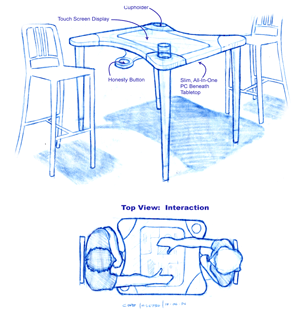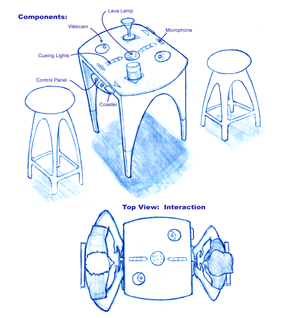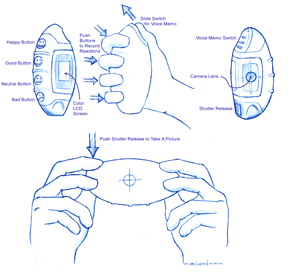
BUILDING A BETTER SPEED DATE
The “On My Mind” project was done as part of the Introduction to HCI Masters course at Georgia Tech (CS 6750). It was a group project through which we learned to apply various usability and evaluation tools while developing a specific product. Each of the four team-members contributed in various ways depending on their particular strength.
My group chose to explore the domain of Speed dating due to the interesting contextual and cognitive factors associated with the process. The project was divided into several deliverables, each pertaining to a different aspect of the user centered design process. These were:
In this first section of the project, we perform a task analysis to fully explore the process of speed dating, and discuss the current systems and aids used by speed daters. Then we discuss the problems with speed dating, contrasting it to other dating methodologies and examining the personal and environmental factors that contribute to those problems. Finally, we detail our priorities in building a solution and conclude with a summarization of our solution’s goals and constraints.
| Task Analysis Diagram |
 |
The Game
Focus: Communication between dates
This design attempts to restructure the speed dating process, guiding the exchange of information, making it easier for the user to capture and review at a later date.
Expressive/Suggestive Environment
Focus: Interaction with the environment
The Expressive Environment provides multi-sensory feedback that gently guides conversation and helps the user form a well-rounded first impression. Meanwhile, data is unobtrusively recorded and logged in the form of both tangible and virtual objects that can return home with the user.
Recording Gadget
Focus: Recording information about dates
In this design, we took a different approach and concentrated all of the systems functionality into a single handheld device. The Gadget would permit both men and women to record information between dates, maximizing privacy and discretion at the expense of information fidelity.
| Game | Expressive Environment | Portable Device |
| (Design drawings by Clint Cope ) | ||
Our final prototype combined two of our favorite designs plus some additional modifications. It is a system of devices, artifacts and software that combine to form On My Mind, a cognitive aid system for speed dating.
Conversation Lights
Conversation Lights Provide ambient cues as to the flow of conversation. Two rows of four lights meet Lights on one side of the table turn on one by when a speed dater starts talking.
Lights turn off one by one, only more slowly when the speed dater stops talking.
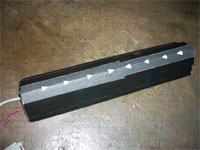
Lava Lamp Timer
Hollow Plexiglas tube with one red and one green LED at each end. Voltage controlled with a six-stage potentiometer Investigator turns. the potentiometer to change the color of light from green to red.
Provides environmental cue as to how much time is left in a date.
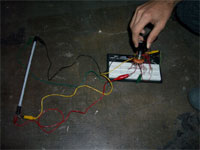
Coasters
Like business cards for participants to swap.
Tangible reminders of a person.
Includes printed photo and biographical information.
Slots into the handheld (Production coasters would have smart chip or mag strip).

Handheld device
Includes small color display, slot panel for the coaster, and a grip. Grip contains three buttons and a microphone

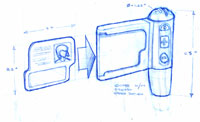
Use
User slots coaster for person just dated. User is prompted to enter compatibility information using the + and – buttons Prompt consists of a simple one-word personal characteristic User may hold down the Record button to enter a voice memo.
Website
A photo of the date, morphed according to the users answers to the prompts. Icons corresponding to compatibility answers.
The conversation light record for the date, presented as a series plot. The voice memos recorded for the date.
Profile information from the dates coaster

Procedure
After the participant arrives in the lab space (a TSRB meeting room) and signs the consent form, we will assign the participant a coded identifier. We will then provide a sixty-second instructional lecture on the usage of the system. The cooperative evaluation then proceeds in three phases.
Phase 1 lasts approximately five minutes. During this phase we dim the lights, put on some music, and the participant and an investigator make small talk across a table. Note that this is not a simulated date – it is intended simply as a conversation. Another investigator manipulates the conversation lights and the lava lamp in tune with this conversation. During this time the participant will be encouraged to share any thoughts he or she has about the lights and the lamp.
Phase 2 lasts approximately fifteen minutes. During this phase, we provide the participant with our handheld prototype. The investigator then reads a prepared “date narrative” – a short story that describes a hypothetical date the participant has just had with a fictional character. The participant is also given a coaster that corresponds to the person, including a photo selected from a stock catalog. The participant must then use the handheld to register their compatibility evaluations based on the narrative and on the coaster. They may also use the voice recording function to record voice memos. During this time we will encourage the participants to “think aloud”, describing their thought process as they complete each step of the task. Each participant will complete three of these narratives.
Phase 3 lasts approximately fifteen minutes. During this phase, we provide the participant with a mockup of the On My Mind website. We ask the participant to pretend that they are sitting with a friend, who has gone to a speed dating session the previous evening. The investigator reads another “date narrative”, this time somewhat more vague, which represents the friend’s memory of one of his or her dates from the previous evening. The participant then looks at the corresponding data record on the website mockup, and makes a compatibility decision to “help” his or her friend. The narrative may conflict with the mockup, representing a memory error. The participant must decide if it was a memory error or an error in using the device. During this time we will encourage the participants to “think aloud”, describing their thought process as they complete each step of the task. Each participant will complete three of these narratives.
Finally, participants will complete an exit survey, in which we ask them to rate the utility and effectiveness of different features of the prototype.
RESULTS
Overall
Overall, the system was found to be both usable and useful.
Handheld
We found that the handheld had No Learnability Whatsoever . However, once learned, users thought the handheld was very easy to use, and most liked using it, or thought they would in a real speed-dating scenario. Overall, they strongly agreed that usage of the handheld system was enjoyable.
Prompts & Categories
The average responses to our first three handheld prompts (“Looks?”, “Smarts?”, and “Intrigue?”) were approximately the same. However, only half as many participants responded affirmatively to the “Chemistry?” prompt. This may be reflective of the experimental design, in which our participants were rating fictional characters absent any real dating experience. It may also be the vagueness of the description – some participants did comment that they would like to see a greater variety of characteristics to rate. Other observations:
- Users confused responses to 4 questions with a rating scale, and thought +/- buttons were for increasing/decreasing compatibility
- Users did not like the fact that the rating schema was binary (‘compatible’ & ‘not compatible)
- Users were not able to navigate through the prompts, and got confused by the cycling method of navigation that is currently extant
- At least two users wanted the ‘+’ and ‘-‘ buttons swapped in position
- Most users looked at the coasters when using the handheld, but not always
Voice Recording
There was a marked gender difference in the usage of voice memos. Every male participant recorded multiple voice memos, while no female participants did so. In reviewing survey responses, this gender difference in attitude towards voice recording also became apparent (one female participant did not answer the voice recording questions on the survey because, she notes, she didn’t use the function). This may be an attribute effect, in that female-gendered attitudes towards relationships may inhibit voicing evaluations in a semi-public context. It may also be a selection effect, due to our small experimental population. Finally, it may be a researcher effect, in that two male investigators were present and within close proximity to the participant when voice memos were being recorded. Our presence may have made female participants uncomfortable making compatibility statements about even fictional characters, while male participants may have been encouraged by a male atmosphere. Some other lessons learned were:
- One user associated the voice memos with the categories
- One user committed a slip while recording the memos, pressing the +/- buttons instead of the recording button. This indicates that more feedback would be required for the voice recording button
Environmental Elements
These features were found to be useful while being marginally distracting, as well as being somewhat enjoyable. The chart below illustrates this.
Conversation Lights
There was a mixed response to this feature. Overall, users thought it was not distracting, but were divided as to its utility.
- Some users disregarded the conversation lights completely
- Some users experimented with the lights to figure out how they worked
Our analysis of the data from the conversation lights was inconclusive. The plot at left shows the graphs generated from participants’ usage of the conversation lights during the experiment. While there were both strongly positive and strongly negative responses from our participants regarding the lights, a correlation of conversation patterns with their reactions fails to show any particular systematic covariance. However, we did discover that our timing of the lights was inappropriate for a conversation pattern that approximates that of a speed date (limited duration, open-ended, and social in nature). While the timing was fine-grained enough, it resulted in large plots that could not be reasonably shrunken for a computer display without losing critical details. We would need to do further experimenting to find the right balance between maintaining an appropriate granularity of data and optimizing for display.
Lava lamp
- Users felt that the transitions not smooth enough
- Some users were confused about what the end state is
- Most thought that it was a good way to keep track of the time
Coasters
The coasters were a hit! People liked the associativity between the coasters and the dates. They also had other observations:
- Users in general thought they’d be useful for sorting & ranking date prior to using the website
- Some users thought that the dots on the coasters should be on the front, for sorting purposes. We agree, for the sake of task effectiveness
- Some users wanted more personalization of the coasters
Web Site
Layout, navigation etc
Users wanted more assistance in comparing the dates, for instance, by viewing all the graphs/photos at the same time, or by viewing only those were rated high enough. Otherwise, they found the website layout & organization of information satisfactory, and felt confident making decisions based on the information presented.
Conversation graphs
- Many users intuited that the conversation graphs ‘meeting in the middle’ meant that the date was a good experience, which is what we intended. They also inferred from the graph of the one of the fictional dates that that person dominated the conversation, which matched the narrative we’d prepared for that date
- However, some thought that the graphs meeting in the middle meant that the dates were talking over each other
- Some users associated the graph with the photo-morphs, or with the categories
Photo morphs
Not successful at all for the following reasons:
- Users thought that they contained redundant information
- Users also found that the morphs could be easily misinterpreted
- The photo-morphs were often overlooked, but users thought that having the original photos on the coasters as a reference might be useful

